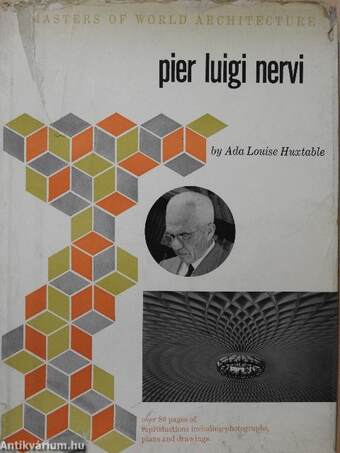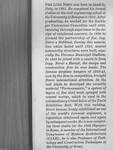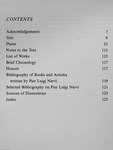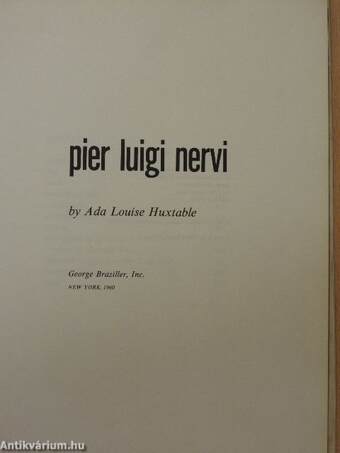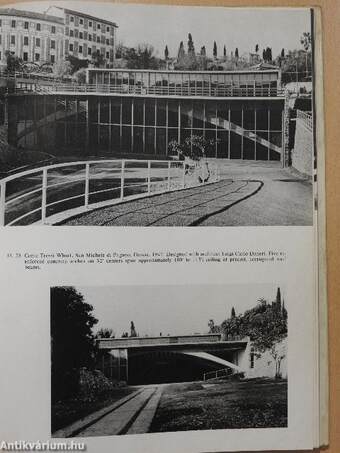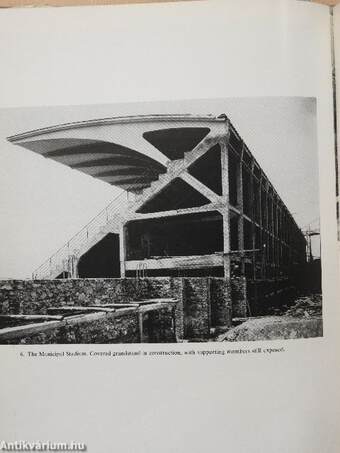1.067.726
kiadvánnyal nyújtjuk Magyarország legnagyobb antikvár könyv-kínálatát

VISSZA
A TETEJÉRE
JAVASLATOKÉszre-
vételek
Pier Luigi Nervi
| Kiadó: | George Braziller, Inc. |
|---|---|
| Kiadás helye: | New York |
| Kiadás éve: | |
| Kötés típusa: | Félvászon |
| Oldalszám: | 128 oldal |
| Sorozatcím: | The Masters of World Architecture |
| Kötetszám: | |
| Nyelv: | Angol |
| Méret: | 26 cm x 19 cm |
| ISBN: | |
| Megjegyzés: | Fekete-fehér fotókkal. |
naponta értesítjük a beérkező friss
kiadványokról
naponta értesítjük a beérkező friss
kiadványokról
Fülszöveg
Pier Luigi Nervi was born in Sandrio,
Italy, in 1891. He completed his formal
studies at the civil engineering school of
the University of Bolognainl913. After
graduating, he worked for the Societa
per Costruzioni Cementizie until 1920,
receiving thorough experience in the de-
sign of reinforced concrete. In 1920 he
formed the partnership of Soc. Ing.
Nervi e Nebbiosi. During this associa-
tion which lasted until 1932, several
noteworthy structures were built, espe-
cially the Florence Municipal Stadium>
In 1932 he joined with a cousin to form
Ingg. Nervi e Bartoli, the design and
construction firm he now heads. The
famous airplane hangars of 1938-43,
won by the firm in competition, brought
Nervi international attention. In the
mid 1940s he developed the versatile
material "Ferro-cemento" a system of
layers of fine steel mesh sprayed with
cement mortar, which he used in the
extraordinary Grand Salon of the Turin
Exhibition Hall. With this building>
Nervi... Tovább
Fülszöveg
Pier Luigi Nervi was born in Sandrio,
Italy, in 1891. He completed his formal
studies at the civil engineering school of
the University of Bolognainl913. After
graduating, he worked for the Societa
per Costruzioni Cementizie until 1920,
receiving thorough experience in the de-
sign of reinforced concrete. In 1920 he
formed the partnership of Soc. Ing.
Nervi e Nebbiosi. During this associa-
tion which lasted until 1932, several
noteworthy structures were built, espe-
cially the Florence Municipal Stadium>
In 1932 he joined with a cousin to form
Ingg. Nervi e Bartoli, the design and
construction firm he now heads. The
famous airplane hangars of 1938-43,
won by the firm in competition, brought
Nervi international attention. In the
mid 1940s he developed the versatile
material "Ferro-cemento" a system of
layers of fine steel mesh sprayed with
cement mortar, which he used in the
extraordinary Grand Salon of the Turin
Exhibition Hall. With this building>
Nervi became firmly established as one
of the world's foremost engineers, a
reputation reinforced again and again
by subsequent works. He is now complet-
ing three stadia for the 1960 Olympics
in Rome. A member of the International
Congresses of Modern Architecture
(CIAM), he is also Professor of Tech-
nology and Construction Techniques at
the University of Rome. Vissza
Témakörök
- Idegennyelv > Idegennyelvű könyvek > Angol > Művészetek > Építészet
- Művészetek > Építészet > Tanulmányok, esszék
- Művészetek > Építészet > Korszakok, stílusok > XX. század > Egyéb
- Művészetek > Építészet > Kontinensek szerint > Európa > Olasz
- Művészetek > Építészet > Idegen nyelv > Angol
- Művészetek > Építészet > Építészettörténet > Külföldi
Ada Louise Huxtable
Ada Louise Huxtable műveinek az Antikvarium.hu-n kapható vagy előjegyezhető listáját itt tekintheti meg: Ada Louise Huxtable könyvek, művekMegvásárolható példányok
Nincs megvásárolható példány
A könyv összes megrendelhető példánya elfogyott. Ha kívánja, előjegyezheti a könyvet, és amint a könyv egy újabb példánya elérhető lesz, értesítjük.



